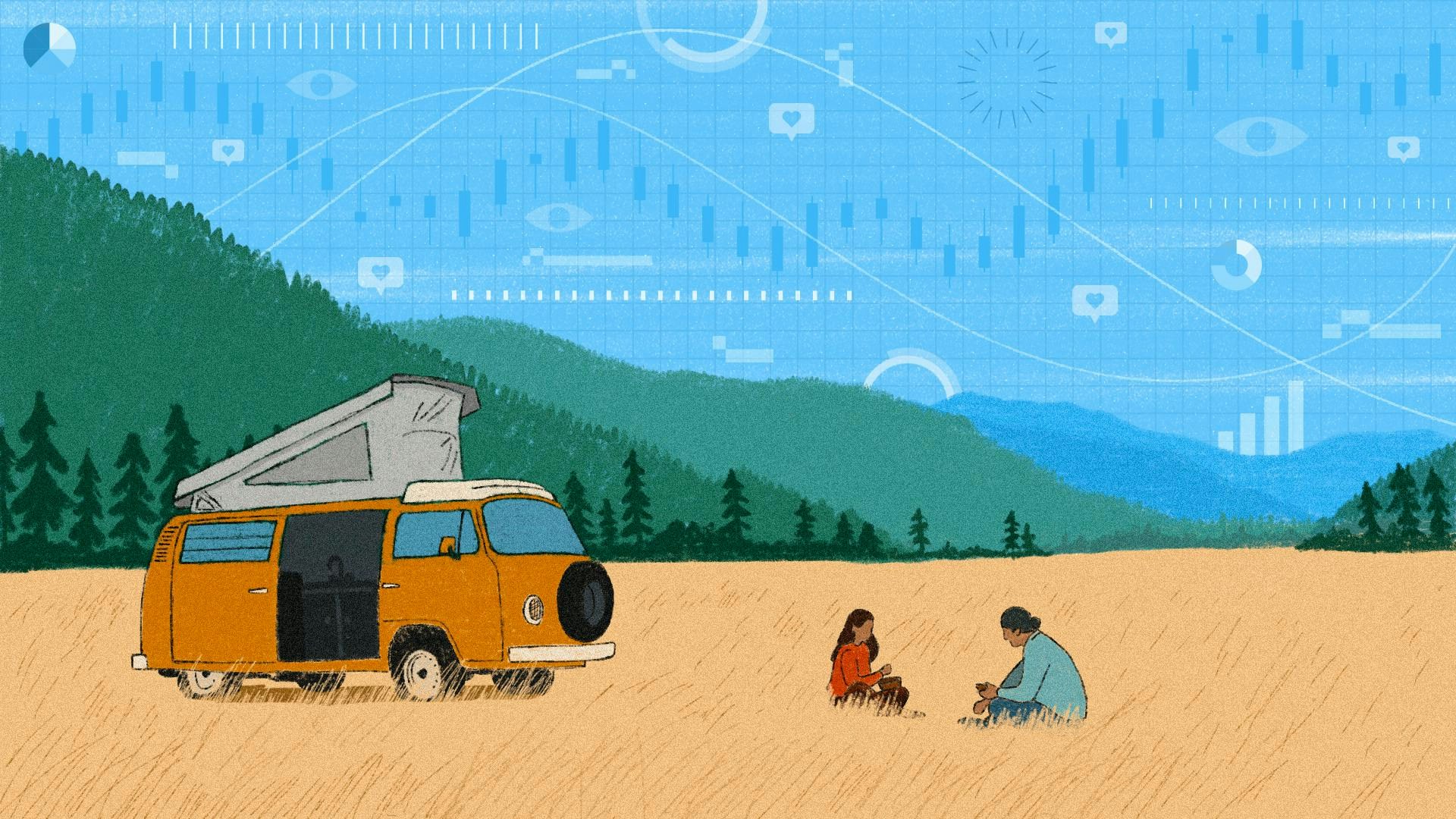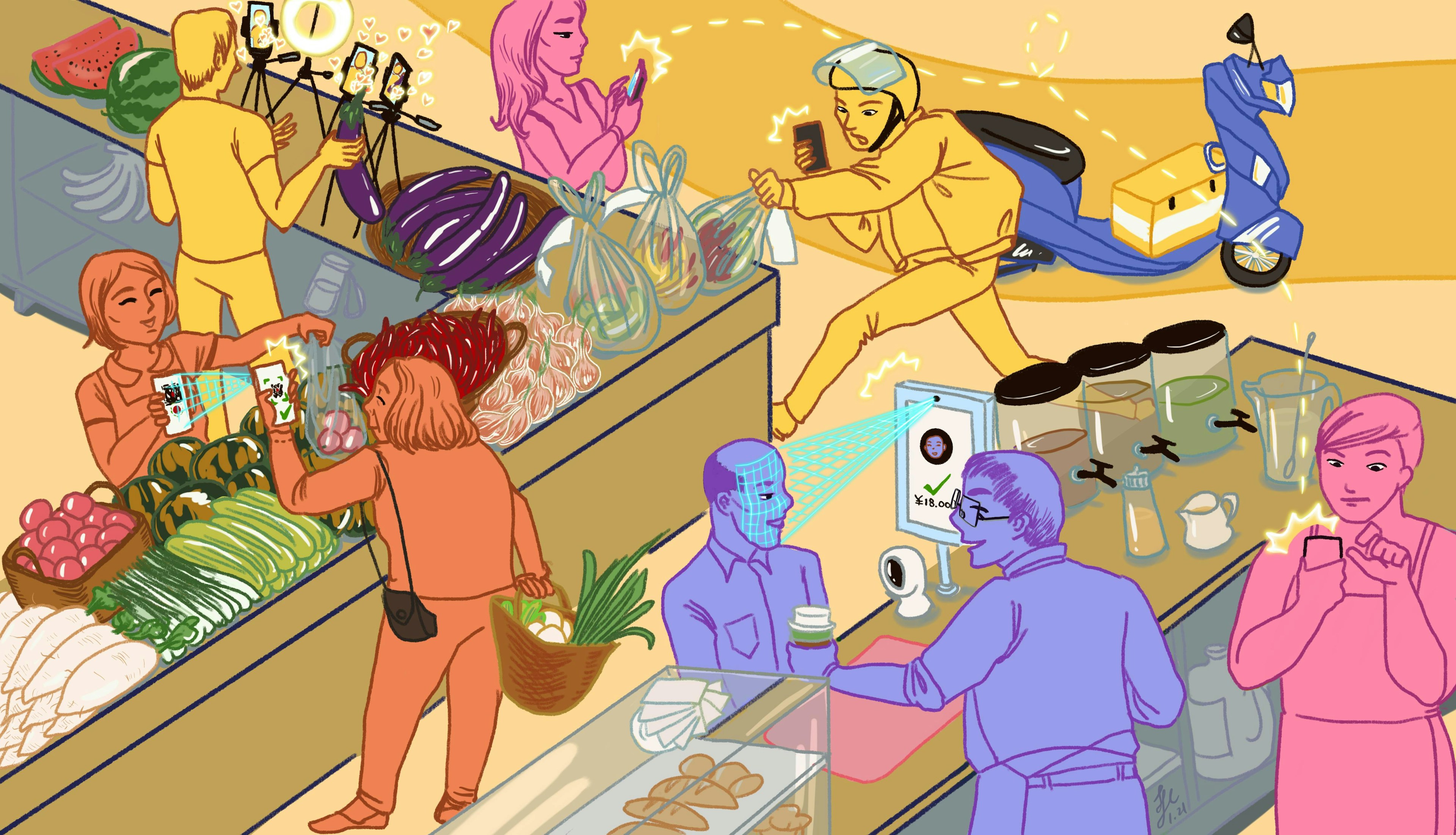Life is a highway, let’s ride it all night: The digital economy’s transformation of van life

The image stops you mid-scroll: a young couple watches an ocean sunrise from a renovated sprinter van. The cozy interior is accented with throw pillows and rugs. Its white kitchen includes a full-sized oven and gleaming marble countertops. A guitar is near the edge of the frame, underneath a shelf of novels, art supplies, and a yoga mat.
You feel a pang of envy. They look carefree and relaxed. Their lives consist of afternoons exploring national parks and evenings gazing at stars. The caption reads: It’s never too late to live the life you want. #vanlife.
What if you, too, could trade it all for a never ending road trip?
Live Long Enough to See Yourself Become the Villain
#Vanlife isn’t new. It was popularised around the early 2010s, when Foster Huntington posted pictures of his experiences driving a van across the US in the early social media days. The first Van Life community galvanised free-spirited, nature loving explorers who rejected the corporate rate race. Unburdened by rent and 9-to-5 jobs, this minimalistic counterculture eschewed consumption for meaning, relying on resourcefulness to turn vans into homes. #Vanlife Instagram posts have risen 312 percent since 2017.
By 2021, the movement was unrecognisable. You can now order a fully-converted van, equipped with hardwood floors, a flat-screen TV, and subway-tile backsplash in the kitchen. The digital economy fuels it with a cottage industry of products and services, including a thriving media ecosystem, where sponsored influencers post unending streams of content, painting a compelling picture of life on the open road.
This new iteration of van life promises adventure without sacrificing comfort, and a reimagined version of having it all, where new horizons and stability can co-exist.
The pandemic also played a part: economic uncertainty decimated whole industries, leaving many without a way to pay rent. Others found themselves thrust into remote work, where they could unshackle themselves from brick-and-mortar offices for the first time. According to Leland Gilmore, founder of van conversion firm Benchmark Vehicles, demand for fully retrofitted vans doubled since lockdowns began. Car Sales Base, which tracks car sales, noted increased demand for Sprinter, ProMaster, and Transit vans, three of Van Life's most popular choices.
People want to get out of their homes and onto the road. 52 percent of respondents in a 2020 survey indicated Covid made them more likely to consider van life. Even countries hopped on the nomadic living trend, with Antigua, Bali, and Barbados offering special digital nomad visas (often called #vanlife visas) to encourage people to combine travel with work. In Estonia, location-independent workers can spend up to a year working in the country legally.
Classy or Trashy? Depends Who’s in the Driver’s Seat
A classic Reddit thread once asked, “what’s an activity that’s classy if you’re rich, but trashy if you’re poor?” Among the highest-voted answers: Living in your car, an activity traditionally associated with homelessness, is not cool … unless you’re rich.
Unlike first-generation Van Life, #vanlife is an aspirational lifestyle, powered by immense privilege. Wealthier vanlifers have families and friends, on whose properties they can park when needed, and to access hot showers instead of dealing with campground fees and parking lots. They can afford top-scale vehicles. Thanks to financial safety nets, those who tire of nomadic living have options, like returning to live with parents while working out their next move.
For others, #vanlife is a byproduct of a fractured economy. Wage stagnation, social inequity, lack of stable job opportunities, and other barriers of upward mobility have locked many out of owning real estate. Even renting is increasingly unaffordable, with people forced to share lodging with roommates, or commute long distances to work.
Is it any wonder that converting a van into a sanctuary has become an attractive option? For these vanlifers, this lifestyle is less about the ultimate road trip, and more about being able to afford living in their cities of choice. In 2018, Hollywood Reporter observed that many people in the film industry, employed full-time, nonetheless chose to live in vans due to the lack of affordable housing: Less chasing sunsets, then.
Despite the appeal of saving money traveling, there are downsides to vehicle living. Even without rent or mortgage payments, maintaining a van is expensive. Varying gas prices limit the possibility of longer trips if budget is an issue. Campgrounds, RV parks and parking lots cost money. Unexpected events, like a breakdown or flat tire, can be devastating, forcing vanlifers to stay at motels or camp if no one can house them until repairs are complete. Potential economic consequences exist if the vehicle is needed to get to and from work, and, unlike houses, vans are depreciating assets that don’t provide equity.
Yet #vanlife has come to represent an alternative to property ownership and a way to live in urban centres. By rebranding vans as homes, living in a vehicle becomes a desirable goal for cost-burdened consumers seeking to participate in the American Dream, lacking traditional markers of success. In some cases, vanlifers pride themselves on rejecting home ownership in favour of this alternative (read: more authentic) way of living.
Offline Powered by Online: An Economy of Contradictions
A thriving digital ecosystem, bridging the online and offline worlds, helps make van life possible.
Content creators rely on sponsors, fan support (like Patreon), and advertising generated from online views. Influencers tend to focus on two topics:
- Content that reflects the aspirational values of the lifestyle. Beautifully-edited images let viewers vicariously experience life on the road. These videos are entertaining and inherently watchable, and appeal to broad segments of viewers.
- Tutorials. Podcasts, newsletters, websites, conferences and seminars contain practical advice for people considering swapping an apartment for wheels. They cover everything from water tank reviews, to suggestions on vehicles to buy. The RV Entrepreneur Summit charges $300 per person for a long-weekend event, dedicated to helping aspiring vanlifers build their own businesses on the road.
#Vanlife content also attracts sponsorship from technology firms. Companies like Samsung and Squarespace partner with popular creators, promoting the ability to “live and work from anywhere.” Services like Amazon Prime are essential to accessing supplies; many #vanlifers rely on quick delivery to get what they need. Influencers can earn anywhere from a few thousand dollars to a few hundred thousand. The popular channel “Keep your daydream” generates up to $88.000 per year in YouTube ad revenue, not including income from sponsors, their podcast, and educational courses. As with any influencer category, a few superstars earn high six figures, while the rest eke out a couple of hundred dollars a month (if that).
Numerous companies provide products and services, aimed at facilitating the experience of being a #vanlifer. Companies that sell DIY conversion materials, like insulation or solar panels, are on the rise, as are service-oriented firms that provide a P.O. box mailing address for people on the move, so they can continue to receive important documents, vote, and apply for credit cards and employment. Insurance companies focused on #vanlife are becoming popular.
Existing industries, like RV conglomerates and campsite operators, have gotten a digital boost, with offerings that cater specifically to #vanlife. Harvest Hosts gives paying members access to campsites that include wineries, breweries, farms, and golf courses across North America.
Analysts predict the RV market will be worth $75 billion by 2025. The European van and minivan conversion market is estimated to reach $1,3 billion by 2027.
The decentralised nature of #vanlife also benefits from the interconnectedness and organisation of the web. Directories like VanX specialise in remote job postings, and popular apps identify free bathrooms and safe parking options in various countries.
But the community’s values reveals a digital market packed with contradictions:
Minimalist vs. the reality of life on the road. Despite the allure of ditching possessions for a streamlined life, #vanlife requires a lot of gear, especially if the vehicle is used as a full-time primary residence. Unlike traditional camping, where backpackers are limited by what they can carry, vanlifers want creature comforts. That means appliances, decor, and other necessities of modern living that must withstand daily use.
Jonathan Feld, president of van conversion company Sportsmobile West, calls durability a major challenge. “You have to build a house that’s going to survive an earthquake every day. We have people going down to Death Valley and Baja. It will rattle the teeth out of your head.” Safety is also a concern; many van conversions violate regulations for seat belt and airbag access. And, far from an endless vacation, this new way of living still involves chores, paying bills, and using the bathroom. Traveling after working can be draining, especially for long periods of time.
Life unplugged vs. the influencer hustle. #Vanlife evokes a longing to explore and connect with nature. It’s a desire for new horizons and a chance to disconnect from noisy modern life. Thus the images vanlifers post are similar: Oceans, forests, books, guitars, sketchpads—shorthands for relaxed, creative living. Ironically, however, selling an aspirational lifestyle that idealises offline living requires influencers to produce social media content non-stop, particularly to maintain high viewerships for sponsorship. They are expected to share aspects of their personal lives, so, despite the appearance of carefree living, significant time is dedicated to creating, editing, and sharing content. This requires structure and planning—not only to produce consistently, but to ensure proximity to reliable wifi. Many influencers find themselves unable to enjoy the very benefits they extoll to their followers.
DIY ethos vs. ready-made shortcuts. Early #vanlifers prided themselves on converting vans themselves, a do-it-yourself rite of passage that signalled their commitment to community values. This DIY ethos has been replaced by intermediaries, erasing the self-builds that were once a core display of authenticity and individuality valued by Van Lifers.
The popularity of #vanlife yielded a cottage industry of shortcuts: Fully-converted vans that cost up to $300.000 (not including the $40.000 cost of the van itself), with year-long waiting lists. A luxury RV that can comfortably sleep five could be purchased for a fraction of the price, but wouldn’t meet the aesthetic #vanlife is known for: Mountain views, not trailer parks. RV companies now offer motor homes built within sprinter vans, but without the same level of customisation (and bragging rights) as conversion companies.
Companies like Campanada and AirBNB make it easier for people to try #vanlife through packaged nomadic experiences. AirBNB normalised the notion of unique rentals (like the ability to stay in a treehouse or cave); in kind, staying in an RV or van is now a desirable experience. The ease of short-term rentals also created the possibility for vanlifers to rent their vehicles as an additional source of income, which is becoming more common as some get older, have children, and divide time with traditional housing (for proximity to schools, for example).
Unburdened freedom vs. remote work reality. The proliferation of remote work, freelance marketplaces like Fiverr and Upwork, and the popularity of digital entrepreneurial ventures (drop shipping, FBA, digital products), creates more opportunities for people to engage in nomadic living. But running an online business or working a remote job is still work. In addition to stable internet connections (often unavailable in rural areas), many people remain constrained by meetings, calls, and other obligations that require access to them.
Vanlife’s also stimulated rising competition for “gig economy” jobs—especially those that can be done remotely, like copy editing, web design or photo editing, leading to higher freelancer rates. #Vanlifers compete for such roles in a global talent market with lower average labour costs, making it even harder to earn an income. In an interview with The New Yorker, vanlife influencer Emily King outlined her difficulties working full-time:
“I was working anywhere from fifteen to forty hours a week, which doesn’t seem like a lot, but when you’re driving around and having all that motion, and what I guess you could call the stress of vanlife—not knowing where you’re going to sleep that night—the anxiety was still there. We could never really go deep into national parks or national forests, because I always had to be on call.”
If the vehicle includes another person, all this professional activity happens in close quarters. Those who cannot work remotely must supplement income in other ways, including part-time jobs that further restrict the ability to pack up and go. Creative options exist: @carabinerscoffee converted their van into an on-the-go coffee shop. A suggested list of vanlifer-friendly jobs includes travel nurse, artist, and sex worker.
Off-grid autonomy vs. urban support systems. No vanlifer can live completely independently. #Vanlife requires an urban ecosystem of support. One community best practice is to pay for 24-hour gym membership, or a campground, to access showers and other facilities. Companies like Target and Walmart let #vanlifers stay in their parking lots, and Starbucks and McDonalds are favoured for their free high-speed internet. Global brands truly make this lifestyle possible.
The Backlash: You Did Not Sleep Here
Behind the “authentic experiences” driving this subculture, numerous untruths persist in vanlifers’ pursuit for clicks, likes, and shares —the real fuel of the digital economy. Even negative lifestyle aspects become fodder for the content machine, with viral videos about burnout, and the drawbacks of living on the road, wracking up millions of views that keep the wheels turning. Eamon & Bec, vanlife influencers that posted about the stress they experienced, generated over half a million views.
A growing backlash is tempering more diffuse instances of dishonesty. One account, @youdidnotsleephere, reposts staged vanlifer photos, pushing back on the notion that it’s possible to simply camp out on a beach. Many ex-vanlifers are speaking out about hidden aspects of the lifestyle, describing how the experience impacted their finances, careers, and mental health. As with any industry, #vanlife has given rise to scams that include everything from shoddy van conversions, to courses that promise to teach hopeful #vanlifers how to earn six figures while living from their vehicle.
There is something unnerving about a movement that sidesteps the societal implications of fewer affordable homes and economic opportunities by glamorising living in a vehicle, especially considering recently-passed laws in several US states, where sleeping in cars can result in fines or jail time. Hyper-curated experiences from a privileged group of influencers mislead others into thinking that this “movement” is financially beneficial without discussing the risks, such as how a gap in residential addresses can impact securing future housing. There are also security risks for women or BIPOC people who are traveling solo, especially in remote areas. The upper echelons of vanlifers lack diversity; the primary figureheads are white.
Full Circle
Often, we focus on new trends and ignore how older ones change with time. #Vanlife is a case study of one community’s evolution, boomeranging between the desire to live off-grid, and the need to be constantly connected. What started as a counterculture movement of minimalism and nature appreciation has mutated in collision with a housing crisis, the influencer economy, the rise of remote work, the gig economy, and a global pandemic. Like-minded nomads used the web to build a network of resources, information, and community that’s made this lifestyle accessible to thousands.
However, that accessibility came with a price: the authentic DIY mentality has been slowly replaced by a powerful e-commerce infrastructure, where anything from portable fridges to fully refurbished vans can be ordered with a click of a button.
#Vanlife also demonstrates how the web can amplify distorted narratives that gloss over real challenges and inequalities, where people are led to believe in the feasibility of a lifestyle actually reserved for a few. It’s not all adventure; many live in vans to reduce costs, save for property ownership, or because they lack other viable options.
The pandemic also created unique strains. At the height of the lockdowns, gyms either closed or stopped accepting out-of-state residents, depriving vanlifers of essential infrastructure. In Europe, some vanlifers, camping legally on private land, scrambled to find other accommodations when police labelled their site an “illegal campground.” Shelter-in-place mandates, and closed public parks, forced many vanlifers to spend extensive time in close quarters. While many dreamed of escape during the pandemic, Covid made living on the road far more complicated.
#Vanlife also points to what feels like the inevitability of constant connectivity in order to function in modern culture. Even a community that revolves around being disconnected is, ultimately, powered by the same infrastructure that prioritises ceaseless production. It is specifically the latter that enables people to pursue nomadic opportunities. In #vanlife’s most current iteration, it’s not the open road that dictates the voyage; it's the digital economy behind the wheel.
27 Jun 2022
-
Rahaf Harfoush
Illustrations by Debarpan Das.
02/03
Related Insights
03/03
L’Atelier is a data intelligence company based in Paris.
We use advanced machine learning and generative AI to identify emerging technologies and analyse their impact on countries, companies, and capital.


